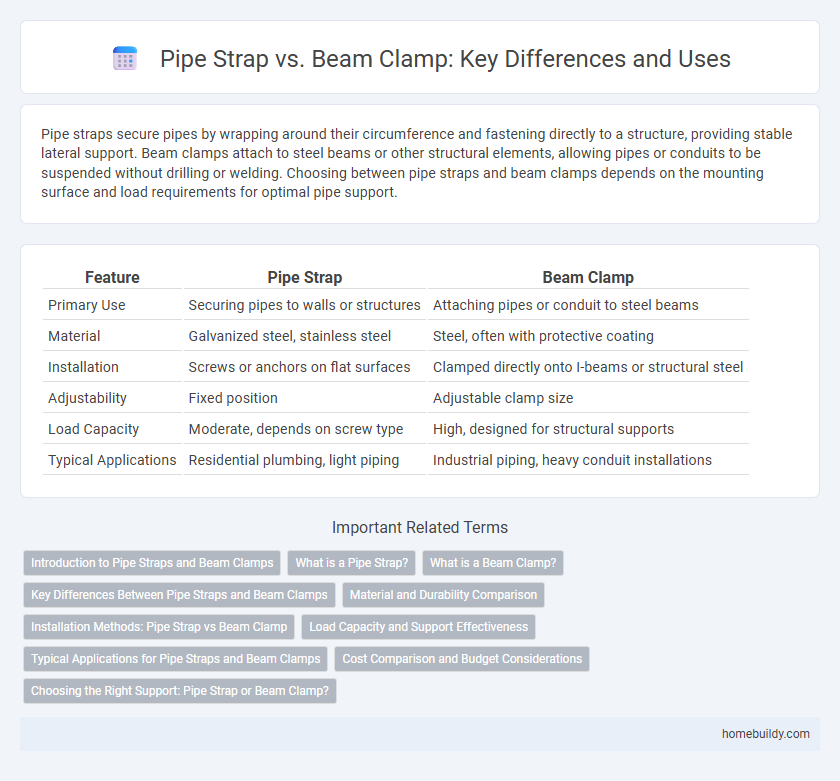Pipe straps secure pipes by wrapping around their circumference and fastening directly to a structure, providing stable lateral support. Beam clamps attach to steel beams or other structural elements, allowing pipes or conduits to be suspended without drilling or welding. Choosing between pipe straps and beam clamps depends on the mounting surface and load requirements for optimal pipe support.
Table of Comparison
| Feature | Pipe Strap | Beam Clamp |
|---|---|---|
| Primary Use | Securing pipes to walls or structures | Attaching pipes or conduit to steel beams |
| Material | Galvanized steel, stainless steel | Steel, often with protective coating |
| Installation | Screws or anchors on flat surfaces | Clamped directly onto I-beams or structural steel |
| Adjustability | Fixed position | Adjustable clamp size |
| Load Capacity | Moderate, depends on screw type | High, designed for structural supports |
| Typical Applications | Residential plumbing, light piping | Industrial piping, heavy conduit installations |
Introduction to Pipe Straps and Beam Clamps
Pipe straps are metal fasteners designed to securely hold pipes against surfaces, offering reliable support in plumbing and electrical installations. Beam clamps attach directly to structural beams to provide a strong anchor point for hanging pipes or conduit without drilling into the beam. Choosing between pipe straps and beam clamps depends on the mounting surface and load requirements, with pipe straps favoring surface attachment and beam clamps enabling secure overhead suspension.
What is a Pipe Strap?
A pipe strap is a metal fastener designed to securely hold pipes in place by wrapping around the pipe and fastening it to a structural surface such as wood or metal. Unlike beam clamps, which grip beams to provide support points, pipe straps directly enclose the pipe, offering stability and preventing movement within plumbing or electrical conduit systems. Their simple design and corrosion-resistant materials make pipe straps ideal for both residential and commercial installations requiring pipe support.
What is a Beam Clamp?
A beam clamp is a fastening device designed to securely attach pipes, conduit, or other hardware to structural steel beams without the need for drilling or welding. Unlike pipe straps, which wrap around pipes to hold them in place against surfaces, beam clamps grip directly onto the flange of an I-beam or similar support, providing a strong and adjustable anchor point. This makes beam clamps ideal for installations requiring non-invasive mounting methods on steel frameworks.
Key Differences Between Pipe Straps and Beam Clamps
Pipe straps secure pipes to flat surfaces by wrapping around the pipe and fastening directly to the substrate, offering strong, stable support for horizontal or vertical piping systems. Beam clamps attach to structural beams without drilling, gripping the beam flange to provide a hanging point for pipes or conduit, ideal for flexible positioning and load distribution in overhead applications. The key differences lie in their attachment methods and use cases: pipe straps are surface-mounted for fixed pipe runs, while beam clamps enable suspended installations on steel structures.
Material and Durability Comparison
Pipe straps are typically made from galvanized steel or stainless steel, providing strong corrosion resistance and long-lasting durability in various environments. Beam clamps are often constructed from carbon steel or malleable iron, which may require additional coatings to prevent rust and wear over time. The inherent material properties of pipe straps generally offer superior resistance to environmental factors, making them more durable for outdoor or heavy-duty applications compared to beam clamps.
Installation Methods: Pipe Strap vs Beam Clamp
Pipe straps install by wrapping around the pipe and fastening directly to structural surfaces using screws or nails, providing straightforward and secure attachment. Beam clamps attach directly to steel beams by tightening a screw mechanism, offering a clamp-based grip without penetrating the beam. Pipe straps suit wood or concrete installations, while beam clamps are ideal for adjustable positioning on steel frameworks.
Load Capacity and Support Effectiveness
Pipe straps provide firm load capacity and effective support by securely fastening pipes to surfaces, distributing weight evenly and minimizing movement. Beam clamps offer adjustable support but generally have lower load capacity due to their reliance on beam flange gripping, which may allow slight slippage under heavy loads. Choosing pipe straps over beam clamps enhances structural stability and load management in pipe installation projects.
Typical Applications for Pipe Straps and Beam Clamps
Pipe straps are commonly used for securing pipes to walls, ceilings, and structural supports in plumbing, HVAC, and fire protection systems, providing stable and durable pipe fastening. Beam clamps are typically employed in construction and electrical installations to attach pipes, conduit, or other equipment directly to structural beams without drilling or welding. While pipe straps excel in fastening round pipes to flat surfaces, beam clamps offer versatile attachment points on I-beams and other steel structures, making them ideal for suspended pipe runs and heavy-duty support applications.
Cost Comparison and Budget Considerations
Pipe straps generally offer a more cost-effective solution compared to beam clamps, especially for light to medium load applications. The lower material and installation costs associated with pipe straps make them an attractive option for budget-conscious projects requiring secure pipe support. However, beam clamps may incur higher expenses due to their specialized design and installation complexity, impacting overall project budget.
Choosing the Right Support: Pipe Strap or Beam Clamp?
Pipe straps offer a simple solution for securing pipes to flat surfaces, providing direct, stable support primarily for smaller-diameter pipes in indoor plumbing or electrical conduit applications. Beam clamps, by contrast, attach directly to structural steel beams, offering adjustable and robust support ideal for heavier loads or industrial environments where pipes need to be suspended. Choosing the right support depends on factors such as load capacity, installation environment, pipe size, and the structural elements available, with pipe straps favored for lightweight, fixed mounting and beam clamps chosen for heavier-duty, flexible positioning.
Pipe strap vs Beam clamp Infographic

 homebuildy.com
homebuildy.com